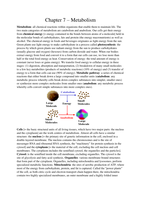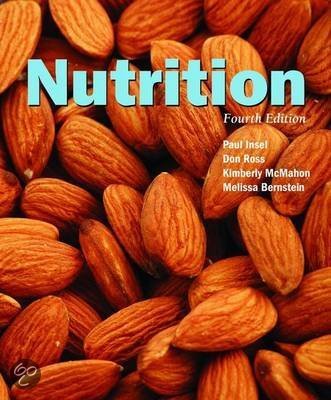Chapter 7 – Metabolism
Metabolism: all chemical reactions within organisms that enable them to maintain life. The
two main categories of metabolism are catabolism and anabolism. Our cells get their energy
from chemical energy [= energy contained in the bonds between atoms of a molecule[ held in
the molecular bonds of carbohydrates, fats and protein (the energy macronutrients) as well as
alcohol. The chemical energy in foods and beverages originates as light energy from the sun.
Green plants use light energy to make carbohydrate in a process called photosynthesis: the
process by which green plants use radiant energy from the sun to produce carbohydrates
(usually glucose and oxygen) (hexoses) from carbon dioxide and water. When our bodies
extract energy from food and convert it to a form that our cells can use, we lose more than
half or the total food energy as heat. Conservation of energy: the total amount of energy is
constant (never loses or gains energy). We transfer food energy to cellular energy in three
stages: (1) digestion, absorption and transportation, (2) breakdown of many small molecules
to a few key metabolites (products of metabolic reactions) (10% of energy) and (3) transfer of
energy to a form that cells can use (90% of energy). Metabolic pathway: a series of chemical
reactions that either break down a large compound into smaller units (catabolism: any
metabolic process whereby cells break down complex substances into simpler, smaller ones)
or synthesize more complex molecules from smaller ones (anabolism: any metabolic process
whereby cells convert simple substances into more complex ones).
Cells [= the basic structural units of all living tissues, which have two major parts: the nucleus
and the cytoplasm] are the work centres of metabolism. Almost all cells have a similar
structure: the nucleus [= the primary site of genetic information in the cell, enclosed in a
double-layered membrane. The nucleus contains the chromosomes and is the site of
messenger RNA and ribosomal RNA synthesis, the “machinery” for protein synthesis in the
cytosol] and the cytoplasm [= the material of the cell, excluding the cell nucleus and cell
membranes. The cytoplasm includes the semifluid cytosol, the organelles and the particles].
Cytosol: is the semifluid inside the cell membrane, excluding organelles. The cytosol is the
site of glycolysis and fatty acid synthesis. Organelles: various membrane-bound structures
that form part of the cytoplasm. Organelles, including mitochondria and lysosomes, perform
specialized metabolic functions. Mitochondria: the sites of aerobic production of ATP, where
most of the energy from carbohydrate, protein, and fat is captured. Called the “power plants”
of the cell, as both citric cycle and electron transport chain happen there, the mitochondria
contain two highly specialized membranes, an outer membrane and a highly folded inner






